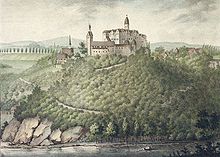Rochsburg Castle

Rochsburg Castle (German: Schloss Rochsburg), which was probably founded in the late 12th century, stands on a rock
History





Although a certain Gunteros de Rochsberg was mentioned several times from the 1190s, it is not certain whether the castle itself was built before 1200. Gunteros was first mentioned in 1195[1] in a Wettin document. The name of the Barony of Rochsburg appears several times in the records of the early 13th century.
In 1283, there is the first record of the burgraves of Altenburg as the vassals of the Wettins at Rochsburg.[1] In 1296, the "castrum Burggravii Rochsberg" is named as the apparently preferred residence of Dietrich II of Altenburg.[1]
In 1329, the castle went, through marriage, to Otto of
The castle went in 1470 for 4,000 guilders as a
In 1547, when Electoral Saxon troops plundered and razed the weakly defended castle during the
In 1637 Christian Ernest of Schönburg became the only owner of the Rochsburg by buying out the others. He left his mark in the layout of the castle gardens.
Increasing financial difficulties forced the owner in 1911 to open up several rooms in the castle to the public as a small museum.
Until 1945, the Rochsburg remained in the possession of the House of Schönburg who had been elevated to counts in 1700. In 1945, the aristocratic family was dispossessed and the property was seized by the state of Saxony.
In 1952 the then county of Rochlitz took over the Rochsburg. In 1992, Rochlitz was absorbed into the county of Mittweida, who continued to use the property.
From 1991 to 1997,
Description

The castle consists of a quadrangular
In the inner courtyard of the inner bailey there is a 53-metre-deep castle well within a wooden wellhouse.
The
References
Literature
- Walter Bachmann: Die Rochsburg. In: Mitteilungen des Landesverein Sächsischer Heimatschutz, Vol. XVII, Issue 5-6/1928, Dresden, 1928, pp. 221–246.
- Matthias Donath (ed.): Schloß und Herrschaft Rochsburg. Beucha, 2006, ISBN 3-934544-92-4.
- Yves Hoffmann: Zur Datierung von Wohntürmen und Bergfrieden des 11. bis 13. Jahrhundert auf sächsischen Burgen. In: Historische Bauforschung in Sachsen. Arbeitsheft 4 des Landesamtes für Denkmalpflege 2000. pp. 47–58.
- Karl-Heinz Karsch: Rochsburg. 1st edn., Schnell & Steiner, Regensburg, 1996, ISBN 978-3-7954-6006-8.
